Rosewood History

(Now Rosewood Uniting Church, 21 John Street, Rosewood)
PART ONE
Acknowledgement: Thank you to Joyce Rieck for assisting with material for this history.
This is a chronological account of the first 100 years of the Congregational Church in Rosewood. The name of the church changed in 1977 to the Uniting Church (combined Methodist, Presbyterian, Congregational). The Church celebrates its 150th Anniversary in May 2025.
THE CONGREGATIONAL CHURCH PRINCIPLE
True to its name, the Congregational Church is governed by the congregation. The congregation determines its own affairs, without having to submit these decisions to the judgment of any higher human authority. Members congregate, contribute, communicate and actively work within their community to fulfil their mission statement “Sharing God’s Love”. It is easy to talk about one’s beliefs but real belief is basically that by which one lives. By doing so, members can witness the church’s spiritual ideal in their personal experience.
HISTORY
The church dates back to the days when the present town of Rosewood was known as Rosewood Gate. The few scattered settlers were visited by Rev. Daniel Mossop when it was just a dense scrub. Rev. Mossop was the minister of the Central Congregational Church in Ipswich. He was known “as a man of great energy and fine faith”.
 As his work took him to all parts of the country, he sought a place in which to establish his family, and after examining various parts of the neighbourhood, he selected a block of 120 acres of land on 29th April 1871, and decided to make a home in the Rosewood Scrub. His future hope was to build a little chapel for occasional meetings for prayer.
As his work took him to all parts of the country, he sought a place in which to establish his family, and after examining various parts of the neighbourhood, he selected a block of 120 acres of land on 29th April 1871, and decided to make a home in the Rosewood Scrub. His future hope was to build a little chapel for occasional meetings for prayer.
(Rev. Mossop built a home on his land at Ashwell. He donated 1acre of the land for a primary school there. The property eventually passed to his daughter Mary Helen Hunt Mossop who married Henry Moreton Stevens. It was called “Wycombe Lodge”.)
Rev. Mossop was moved interstate to take charge of the Newtown Church at Sydney in July 1873. He and his family returned to Queensland per the City of Brisbane in October 1874 so he could re-engage in the work of the Bush Mission.
As a result of Rev. Mossop’s ministry, in 1874, one of the early settlers, Samuel Waight opened his family home (just a humpy then) as a place where folk could gather for worship and fellowship closer to the township. Months later these gatherings were so successful, and the number of worshippers had increased to such an extent, that the need for a dedicated church building became pressing.
The Reverend spent almost four years at the Rosewood Church until he was moved in August 1878 to take charge of the Goodna Church. During his time at Rosewood he successfully laboured to see that a church was built and paid for, and he won for himself the esteem and affection of the people, both as their minister and as their friend.
 1875
1875
A small, unpretentious, shingled church was erected at a cost of £125 on land donated by Mr. William Mathew (pictured), one of Rosewood’s earliest settlers. The church opened as the Rosewood Congregational Church on 24th May 1875. The church was a neat little structure of about thirty feet in length by twenty-five feet in breadth. It was painted and fitted with seats.
The opening was celebrated with a tea-meeting at 1 o’clock and it was attended by a large number of residents of the district. The visitors from Ipswich were not nearly as many as were expected because there were no excursion trains as usual, a fact that was strongly commented on by several of those at the meeting. Even so, the capacity of the building was insufficient. As the tables were vacated, others filled their places.
 After the tea-meeting a public meeting was held. Mr. James Foote, M.L.A. presided. Addresses were delivered by the Rev. E. Griffith, of Brisbane; the Rev. J. T. Waraker, of Toowoomba; the Rev. D. Mossop; Mr. Simon Fraser, M.L.A, of Brisbane; Mr E.W. Hargreaves, of Ipswich and other gentlemen.
After the tea-meeting a public meeting was held. Mr. James Foote, M.L.A. presided. Addresses were delivered by the Rev. E. Griffith, of Brisbane; the Rev. J. T. Waraker, of Toowoomba; the Rev. D. Mossop; Mr. Simon Fraser, M.L.A, of Brisbane; Mr E.W. Hargreaves, of Ipswich and other gentlemen.
Mrs. James Foote collected some £14 towards the building fund. The collection at the meeting amounted to £7 odd, and the sum of £30 was promised in the room. There was still a considerable debt left on the building. William Mathew became the caretaker of the Church for £2 per year and the grounds were let out to pasture an animal at 1/- per year.
1876
The Church Anniversary tea-meeting held on the Queen’s birthday in May 1876, was one of the most successful gatherings ever held in the Rosewood district. Large numbers assembled. 130 visitors arrived by the 8.15a.m. train from Ipswich, in special carriages provided for the occasion. The children engaged in games in Vance’s paddock. Some of the adults passed the time playing croquet, cricket and other activities while others took strolls to the scrub and enjoyed the beauty of the scenery for which the Rosewood is so celebrated.
The paper reported: When 1 o’clock came a scene was witnessed within the neat little church which spoke volumes for the invigorating influences of the climate of Southern Queensland. The tocsin was sounded, in colonial fashion, and a general stampede was made in the direction of the church. About 300 people assembled for the purpose of participating in this very important part of the proceedings, but as these could not be accommodated at one sitting, the seats around the festal board were besieged no fewer than three times. The spread was undoubtedly one of the best we have ever seen on similar occasions, and the ladies of Rosewood are certainly to be complimented upon their catering abilities. After a vigorous onslaught had been made upon the excellent repast provided, a short adjournment took place for the purpose of arranging the building for the holding of the customary after meeting.
The church was filled in every part and was not able to accomodate all of those who wished to attend. Mr. James Foote, M.L.A., for the district, presided. The choir from the Ipswich Church led the people in singing Sankey’s popular hymn “Hold the Fort”, after which the pastor of the Church, the Rev. Daniel Mossop, engaged in prayer. He stepped forward to loud applause and addressed the assembly about the financial affairs. He said how pleased he was that the Sabbath services were well attended and that the Sunday School was in a prosperous state. At the conclusion of his address the beautiful hymn, entitled “The Gate’s Ajar,” was sung by the audience.
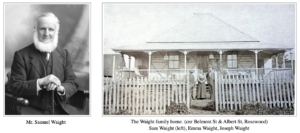
1877
After the previous year’s tea-meeting, organisers realised that the church was too small to accomodate the visitors so a large tent was erected outside the chapel to accommodate the people who wished to attend. The Congregational Temperance Society began holding monthly meetings in the Church. It was felt they proved useful in developing the youthful talent of the district. This continued in ensuing years.
1878
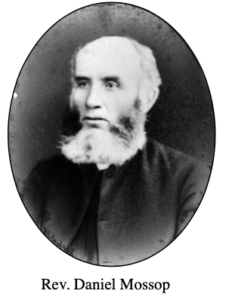 In May, at the Anniversary tea-meeting, Rev. Mossop said he was glad to be in a position to say that, although he was not able to conduct services as often as he would like, they were being well kept up by friends from Ipswich and elsewhere. The Sunday-school continued to flourish and the monthly temperance meetings were still attended. There was still a small debt of about £20 upon the building, and the object of that meeting was to raise funds for the purpose of liquidating it.
In May, at the Anniversary tea-meeting, Rev. Mossop said he was glad to be in a position to say that, although he was not able to conduct services as often as he would like, they were being well kept up by friends from Ipswich and elsewhere. The Sunday-school continued to flourish and the monthly temperance meetings were still attended. There was still a small debt of about £20 upon the building, and the object of that meeting was to raise funds for the purpose of liquidating it.
Queensland Times, Ipswich Herald and General Advertiser , Saturday 24 August 1878, page 3
The Rev. D. Mossop has left the Rosewood Scrub to take charge of the Congregational Church at Goodna. A few friends who have known him long and valued his services asembled at Mr. Vance’s on Wednesday last to present him with a tea-service on the occasion of his departure from amongst us. Mr. J. W. Vance, in appropriate words, informed Mr. Mossop that a few members of his congregation had determined on giving him a tea-service – a slight token of the esteem in which he is held by those who know him best. He should not look upon a light gift of this kind as anything more than a mere acknowledgment that they were deeply indebted to him for his services, rendered during the last two or three years in building a church and providing for regular worship therein. He could not find words to express the many obligations they were under, and the only way they had of giving expression to their feelings was by offering him the service on the table before them.
Mr. Mossop replied at some length, and expressed his grateful thanks to the kind friends in the Rosewood Scrub who had contributed to the fund. He assured them that he did not work for fee or reward. He had a duty to perform: he served a Master who rewarded His servants in His own way. He said he always liked the neighbourhood, and felt considerable regret at leaving a place where he had received much kindness. He wished to see them all prosperous and happy, and hoped still to take a lively interest in the office of the Church which he had established in the place.
Mr. Hannant said he hoped Mr. Mossop wonld be successful in his new sphere of duty, and assured him that the Rosewood people would not forget the good he had done in the district, nor the sacrifices he had made for the Church. August 21.
1879
On the 11th June a meeting was held at the Congregational Chapel, with the view of resuscitating the Band of Hope, and officers were appointed. Mr. John Lane, a man of much enthusiasm, was appointed president.
1880
Churches were plentiful in the Rosewood Scrub, but ministers were like angels’ visits, few and far between. In December some of the residents near the Gate invited the Rev. Mark Dixon to become their pastor in conjunction with another church at Murphy’s Creek. He accepted the offer and came to live at Mr. Richard Mason’s farm at Rosewood Gate.
1881
Rev. Dixon also commenced holding services on Sunday 13th February 1881, in a house near Baker’s Royal Oak Hotel, Walloon. Thereafter he went to Walloon on every alternate Sunday. In November 1881 the Rev. Dixon left for the Goodna Manse. He still continued to conduct the services in the Rosewood church in conjunction with those at Goodna.
1883
Rev. Thomas Ernest Pierce arrived in February 1883. He was only at Rosewood briefly and was moved to Roma by August 1883. He resigned his charge at Roma in November 1885 to enter Camden College and eventually became ordained. He went on to become the editor of the Maitland Mercury and died in 1925 at Maitland, New South Wales.
On March 15th, 1883, the charter of the Success of Rosewood Lodge, No. 22, P.A.F.S.O.A., was granted, and on March 20th the first meeting was held in the Congregational Church building.
1884
In June 1884 the Rev. William Brown was assigned to the Goodna church. He also had the pastoral oversight of Rosewood.
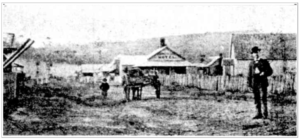 The Congregational Church can be seen on the right behind the man. The Commercial Hotel is in the background. c.1885
The Congregational Church can be seen on the right behind the man. The Commercial Hotel is in the background. c.1885
1885
In October 1885 Rosewood was put under the charge of the Ipswich Church.
1886
Overseeing two churches which were 20 miles apart took it’s toll, and in 1886 Rev. Brown relinquished the care of Rosewood church and confined his efforts to Goodna. The Church then became a branch of the Ipswich Church. Rev. William Brown died at Goodna Parsonage in October 1877 aged 45 years.
1888
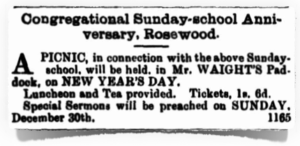 On 4th March 1888, a fellowship consisting of 11 members was formed by Rev. J. Walker, (minister of Ipswich Central). Mr S. Waight of Rosewood and Mrs D. Elder of Cleveland were supervising members. At this time there were about 90 adherents. Rev. James Davies (of the United Welsh Church, Blackstone) conducted a fortnightly Bible class.
On 4th March 1888, a fellowship consisting of 11 members was formed by Rev. J. Walker, (minister of Ipswich Central). Mr S. Waight of Rosewood and Mrs D. Elder of Cleveland were supervising members. At this time there were about 90 adherents. Rev. James Davies (of the United Welsh Church, Blackstone) conducted a fortnightly Bible class.
On Thursday night, 31st May, there was a large attendance of members and adherents at the Rosewood Congregational Church to honour Mr. Francis William Johns. He received a testimonial in recognition of his valuable services as organist of the Church during his long residence at Rosewood. He had been the State School teacher at Rosewood for a number of years and had been transferred to Goodna.
The Rev. Charles Travis Roper (who was temporarily appointed to assist Rev. Walker at Ipswich in November 1888) maintained the ministry here.
1891
The Rev. Hugh Gibson was appointed. The pulpit in the Church was the work of Rev. Gibson.
In December 1891 he had a nasty accident. He was travelling back to Ipswich from Rosewood with the Rev. J. Davis when a short distance from town a branch of a tree, which, was lying across the road, got between the wheels of their trap. Rev. Gibson was thrown heavily to the ground and received bruising on his body and a severe wound on the left knee as a result of the incident.
He met his death in a fall from a horse at Coulson during his ministry at Flinders on 25th August 1895. His wife Mary died at Ashwell Farm, the home of Mr and Mrs George Loveday in 1937. Her funeral service was held in the Rosewood Congregational Church on the anniversary of her husband’s death.
1892
Rev. Henry Rawlings resigned his pastorate of the Broadway Congregational Church in order to take charge of the Rosewood district of the Ipswich Church. He started his ministry here on the first Sunday in November 1892. He also had charge of the churches at West Ipswich, One Mile and Amberley. During his ministry he founded the church at Mt. Walker. Ill-health caused his retirement from the ministry and he died 3rd December 1897. He had been active also in the Peak district.
1896
On Friday night 18th September, in Collett’s Victoria Hall, twenty members of the Athenian Gymnasium Athletic Class from Ipswich took part in a concert and gymnastic display in connection with the Rosewood Congregational Church. A squad of twelve under the direction of Mr. W. E. Foote, gave a great display of athletic and gymnastic exercises. These consisted of maze-running, parallel and horizontal bar feats, and dumb-bell drill. Mr. Pommar performed his Indian club swinging movements. Messrs. Edgar J. Foote and W. C. Popple were loudly applauded for their songs, as were Messrs. Norman Evans and George Young for their recitations. The affair was a great success with proceeds going to the Church Incidental Fund.
1897
Plans and specifications to build a Manse were drawn up. The building was to be 24ft by 26ft and would be erected at a cost £130. Tenders were called for labour (only). These had to be submitted by 18th December. Mr. Hoffman’s tender of £20.10.0 was accepted. Time allowed, six weeks.
Rev. Ralph Figgis began his ministry in December 1897. He came to Rosewood from Peak Mountain (now Peak Crossing). He was the first resident minister at Rosewood.
1898
Rev. Figgis was welcomed at a social on 25th January. He was supposed to lead his first service at a tea meeting on New Years Day at the show grounds. Owing to the whimsical ways of Jupiter Pluvius (it rained), that didn’t happen. He said one of the first things he wanted to do was form a choir and improve the singing on Sundays.
The Rosewood Masonic Lodge was dedicated at a ceremony in the Congregational church building on 29th May. The Lodge opened and consecrated their own building 11th October 1902.
This was reported in the The Week on Friday 28th October 1898.
“A manse has been erected and the church enlarged (by 15 ft) and reseated at Rosewood.”
Some years later the manse was moved closer to the church, and two rooms added on southern side. Since then the back of the building has undergone many changes.The big wide verandahs have been a boon to mothers with young children.
Rev. Ralph Figgis was ordained 17th November 1898 in Ipswich.
1900
The old Farmers’ Club Hall was purchased for £40, plus £5 for seats, to make way for a new hall.
By mid September the contractor had completed the new Farmers’ Club Hall. He also had the contract for removing the old hall to the land belonging to the Congregational Church. It was moved beside the Church for use as a Sunday School. The Church made an agreement that the Farmers’ Club could have the use of it on show day for luncheon purposes. (The showground then adjoined the Church ground.)
The Superintendent of the Sunday School at the time was William Yarrow.
In the photo below the building on the right is the original Church. The building on the left is the old Farmers’ Hall which was moved from next door to beside the Church. The two buildings were eventually joined with the hall across the back of the Church making a “T shape.
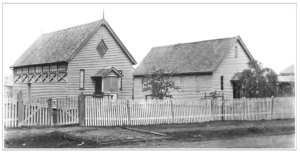
1902
Rev. Figgis left Rosewood in May 1902 for a mission station at Eccleston. At their farewell social
Mrs. Figgis was gifted a lovely silver-backed hair-brush, bearing her initials, and Mr. Figgis was presented with a gold watch with an inscription inside, “Presented to the Rev. R. Figgis from his Rosewood friends, May 24, 1902.” On the outside of the case were this initials. He had proved to be a popular figure, and the work of the Master had prospered.
Mr. Figgis planted the elm tree which still sheds its leaves over the Manse yard, but gives a shady spot to shoppers as they pass by. It is recorded that he left behind him a compact and devoted Church, an enlarged building and a cosy manse.
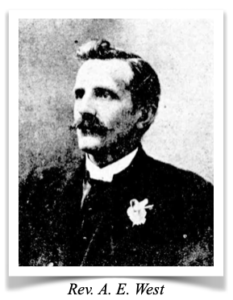 Rev. Albert Edward West was welcomed as minister on 16th October 1902. Rosewood, Mt. Walker and Amberley were under his pastoral care, with cottage meetings held at Calvert and Grandchester. Walloon opened their church in 1900 after holding their services in a slab hut. Walloon was a branch of Ipswich Central but then became linked with Rosewood.
Rev. Albert Edward West was welcomed as minister on 16th October 1902. Rosewood, Mt. Walker and Amberley were under his pastoral care, with cottage meetings held at Calvert and Grandchester. Walloon opened their church in 1900 after holding their services in a slab hut. Walloon was a branch of Ipswich Central but then became linked with Rosewood.
1903
A tennis club was established at the Congregational Church and it flourished. A social to celebrate its formation was held on Saturday evening 7th March in the Farmers’ Hall. The Rev. A. E. West was the Chairman. The programme consisted of vocal and instrumental music and games. Songs were rendered by: Mr. M. Bolton, Rev. A. E. West (“The Village Blacksmith), Miss Hohnke (“The Sunflower and the Sun”). Those who performed duets were: Mr. and Mrs. W. Ruhno (“The Happy Policeman”), Misses L. and I. Collett (”Larboard Watch”). Mr. Tuffley and Misses Nellie Hodge and Jessie Burns played a selection on the pianoforte. Mr. Tuffley was accompanist for all the songs with the exception of Mr. Bolton’s, for whom Mrs. Bolton played. Refreshments were handed round about 11 o’clock, and the singing of a verse of the National Anthem concluded a pleasant evening.
1904
At the anniversary service it was announced that the proceeds from the day were sufficient to free the whole of the Church property from debt, as only £14 was owing.
1905
A mission lasting a fortnight was held with meetings each night. Forty-one folk of various denominations responded to the call to give their life to Christ.
The President of the Queensland Congregational Union, Rev. A. J. Griffith, made an official visit to Rosewood on 26th and 27th February. He was one of the most cultured and thoughtful men in the colonial ministry and his visit was eagerly anticipated. He preached twice in the Rosewood Church, at 11a.m. and 7.30 p.m., and on Monday evening he gave his presidential address in the same place. He was the first President to visit Rosewood. Many have been welcomed here since.
1908
Rev. West resigned at the end of 1907 to take up the pastorate of the Congregational Church at Eagle Junction. He was to begin there on the first Sunday in March 1908. He conducted his farewell service at Rosewood on 26th January. Mrs West had been the president of the Rosewood Branch of the Christian Temperance Union. A gold watch was presented to Rev. West by the Rosewood people. A gold Albert, given to him by the Amberley people at the same time, was later stolen. The first case of finger print detection in Queensland was over that loss.
Rev. Arthur Castleman M. A. was the next minister. Rev. Castleman came to Rosewood from Sydney at the beginning of July. He was welcomed at a social evening at the church on 14th July. There was a large gathering and Mr. John Sellars presided. This was followed by a public function on Monday 20th July. Upwards of 200 people attended. During the evening musical items were rendered under the lead of Mr. Fred Dutney and at the close of the evening a band of 25 lady workers handed round refreshments.
At a meeting held in the Hall on Monday, the 3rd August, a Young People’s Guild was formed. The membership-fee was set at one shilling per annum and was open to all persons 13 years old and upwards. The object of the society was mutual help and encouragement in all that pertained to the highest well-being of its members. The first meeting took place on the 17th when 42 members were enrolled. The President, Rev. Castleman, outlined the objects of the guild stating that the mental and physical improvement of the members would receive attention.
In October 1908, Mr. G. B. Gill, architect, of the “Queensland Times” chambers, received tenders for pulling down the Church and Sunday School, and erecting, with new and old material, a new Sunday school. Overtures were sent in by Messrs. Loynes and Paten, J. Thompson, C. H. Tongue, C. Ridsdale, and Laister and Woolley. The prices ranged from £194 10s to £374 15s.
1909
The new Congregational Sunday school, which was to be used for church purposes until the erection of the proposed new church, was opened on Sunday 7th February. The services were conducted by the Rev. A. Castleman. A pleasant feature was the singing of the choir under the able leadership of Mr. F. J. Dutney. Solos were sung by Misses T Dutney. E. Jacobs and E. Strenzil. Miss Jessie Burns presided at the organ. The new building could hold about 200 persons. Two buildings, the Church and Sunday School were put together in the shape of a “T” and served as Church, Sunday School and Hall. Improvements were made over the years, both to the Church and Sunday School. A platform was built with a communion rail (the work of a Mr. Rutter). Curtains were placed across the wings to provide more class rooms.
Here is the report from page 8 of the Queensland Times on Wednesday, 10th February 1909.
The opening services in connection with the new Congregational Church and Sunday school at the above centre were celebrated on Sunday last. The services, morning and evening. were conducted by the pastor (the Rev. A. Castleman, M.A.), and were well attended, and the pastor was evidently in touch with his hearers. In the morning he preached an impressive sermon from II. Chronicles, vii., 40-41, relating to the dedication of the temple. In the evening, the text was taken from John iv., 21-24, the discourse being equally as eloquent as the previous one, and the lessons inculcated by the preacher will, no doubt, be long remembered by the large congregation present.
The members of the Church at Rosewood may, be congratulated on their new building. It is by far the largest building in Rosewood, having, in all 2330ft of floorspace. It is on blocks nearly 6ft out of ground on the one side, and is built in the shape of a T, with senior and infant classrooms at the back. The whole is cove-ceiled, well ventilated, and painted inside and out, the acoustic properties are good, the preacher’s voice, without any particular effort, being heard in every part of the building. The architect was Mr. G. B. Gill, of your city, who has designed and supervised a most suitable building for the purpose, a Sunday school eventually, but used for services as well at present until a new church is erected.
The contractor was Mr. C. Ridsdale, of this township, who has carried out his work faithfully and well, for which be deserves great credit. The officers of the Church are well pleased with he work accomplished, and I with the proud position in which they find themselves. A large amount of work has been done during the year, and it has only been by the united efforts of the whole of the congregation that the officers have been. enabled to carry the wort through.
Before the arrival of our present pastor, in March last, the manse was enlarged and renovated at a cost of over £130. This debt was all met when due. Then the present cost of buildings totals over £220, making a sum of £350 raised for building purposes during the year, and when the new building was opened not one penny of outside debt was upon it so far as the contract price was concerned. This speaks well for the energy and self-sacrifice shown by the whole of those interested. We can well say, “The people have a mind to build” and build they have done, and paid the debt and we hope, very soon, to see the new church in progress, which, when completed will be a monument to the progressive body in Rosewood called Congregationalists.
 1910
1910
Rev. A. Castleman was president of the committee of the Rosewood School of Arts in September when a plan for a proposed building for their purpose was submitted and approved.
1911
During Rev. Casleman’s pastorate a request was made from the Walloon Church to hold services at Kirchheim (later Haigslea). These were held and a church was established in 1911, becoming another branch of the Ipswich Central Church.
A social was given for Rev. Castleman on 12th July to celebrate the three years he had been Pastor. In his address, he reminded the people of what had been accomplished in those years. A fine and commodious building had been erected in the place of the old building, which had done service for over 30 years. New fences had been put up all round the property, and acetylene gas had been installed. Only £25 remained owing on all of the property after these improvements, costing some hundreds of pounds.
1912
Rev. and Mrs Castleman left at the end of September. At a farewell function, Mr A. Gower (senior deacon), presented Mr. Castleman with an engraved gold watch and gold-mounted chain as a small token of the esteem in which he was held by his many friends. He also presented to Mrs. Castleman two pair of sterling silver serviette rings, suitably inscribed, and hoped she would accept them in remembrance of her friends in Rosewood. (Both gifts were the work of Mr. D. Goldstine, of Ipswich).
 1913
1913
Rev. Alexander McKinlay accepted the call in 1913 and stayed till April 1916 when he was moved to Tivoli. He was a man of retiring nature, but sincere in his message to his people at all times. Having to ride a horse as his means of transport did not deter him in his visitation programme. He was later accepted into the Anglican Church in 1923.
1916
The Sunday School picnic order for New Year’s Day, 1916 consisted of: 24 double loaves bread; 24lb. block cake; 36 doz. tarts;12 doz viennas; 12 doz Queen cakes; 12 doz assorted; 101b. corn meat; 40lb. ham; 101b. butter; 1 block ice; 24 doz. bananas; 2 cases apples; 7 gallons milk.
Rev. Cummings Air Capern and Mrs Lizzie Capern arrived at the manse in April 1916. He had been ordained at Brighton Road Church, South Brisbane, in 1915.
By this time the 1st World War was heading towards the end of its second year and one of the most bitterly contested and costly battles of the War, the Battle of the Somme was looming. Many of the young men of the district had answered the call of the Nation. Over 58,000 Queenslanders would serve and over 10,000 would lose their lives.
The ladies of the Church banded themselves together on 10th June 1916 and decided to assist the Church in any way they could. The Women’s Guild was formed with Mrs. C. A Capern as President; Mrs. G. Brown as Vice-president; and Mrs. T. Harding, as Secretary and Treasurer. As a body they rendered yeoman service to the church, assisting both socially and financially. The Guild took on catering work and various fundraising activities such as the future annual fetes where handwork, cookery, sweets, pantry and produce stalls were presented and displayed items were judged. The ladies also took on the responsibility for the arrangements for the Anniversary Tea Meetings each year. The birthday of the guild was celebrated annually in the years to come.
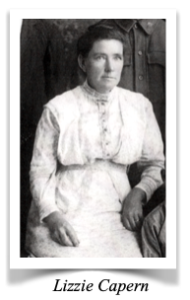
 On Sunday 27th August, the Rev. Capern addressed the congregation. He strongly condemned the patriotic dance that was held in the Farmers’ Hall on the previous Saturday night in connection with the “Do Without Week.”‘ The Reverend entered an emphatic protest against raising money for patriotic purposes by dancing and euchre parties. Seeing that the Nation at the time was plunged into mourning and grief by the disastrous war, he could not understand how the people of the town allowed money to be raised in such a manner, particularly when news had arrived during the day of the death of a young soldier in France, who was known to practically every resident. Whether people agreed with him or not, this was his honest conviction.
On Sunday 27th August, the Rev. Capern addressed the congregation. He strongly condemned the patriotic dance that was held in the Farmers’ Hall on the previous Saturday night in connection with the “Do Without Week.”‘ The Reverend entered an emphatic protest against raising money for patriotic purposes by dancing and euchre parties. Seeing that the Nation at the time was plunged into mourning and grief by the disastrous war, he could not understand how the people of the town allowed money to be raised in such a manner, particularly when news had arrived during the day of the death of a young soldier in France, who was known to practically every resident. Whether people agreed with him or not, this was his honest conviction.
On Sunday 3rd September Rev. Capern conducted a service in memory of Sergeant Edwin James Bertwistle and Private Cecil Stewart Owen (Railway Department at Grandchester), who had been killed in France on 4th August and 29th July resp. The preacher paid a tribute to the self sacrifice of the two men, who were highly respected in the district.
In November Mrs. Capern received word that her father, Mr. Austin, had died on a steamer on the way to Sydney.
1917
The P.A.F.S.O.A. honour board was unveiled by Br. G. . H. Shillito (grand trustee) in the Rosewood Congregational Church on Saturday 31st March.
 1918
1918
Like many other families the Manse folk received the sad news of a son paying the supreme sacrifice. Their son Private Jack Capern was killed in action in France 8th August 1918. He was formerly an employee of the Brisbane Newspaper Company. At the Rosewood Congregational Church, on Sunday morning, 27th September the Rev. Capern conducted a special thanksgiving service for the success of the Allies in Palestine.
1919
On Wednesday night 9th April, the Congregational Union Assembly was held in Rosewood for first time. Since then, there have been several visits made, but not a full Assembly. Rev. Capern, chaplain of the order, welcomed the visitors, said it was a pleasure to see so many Protestants assembled to honour the members of the society who gave their life, the same as their forefathers did, for freedom and liberty. Two retiring Sunday School teachers, Mesdames Evans and Jacobs, were presented with inscribed gold medals by Rev. A. H Austin.
1920
A handsome marble honour board containing 42 names was unveiled on Sunday morning 26th December 1920 at the Congregational Church, by the Rev. A. H. Austin, M.A., of, Ipswich. The choir rendered the anthem, “He wipes the tear from every eye.” Mrs Makin presided at the organ. Mr. Austin delivered an address on the “Effort of the war on civilisation.”
1921
A week’s mission was conducted in the Rosewood Congregational Church by Evangelist W. L. Jarvis beginning 17th June.
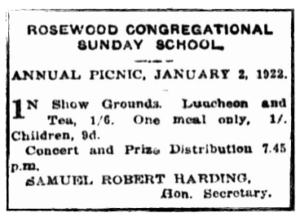 1922
1922
During this final year of Mr. Capern’s ministry, Rosewood and district churches, consisting of Rosewood, Mt Walker, Haigslea and Walloon, became an independent charge. However it was still overseen by the Central Church. Prior to this contributions were made annually to the Central Church towards the Minister’s stipend.
Mr. Capern was elected as President of the Union while in Rosewood. He left Rosewood in1923 for Blackstone and died in 1946.
1923
Rev. Nelson Howard Finch came from Imbil to commence his ministry. He was welcomed at reception on Thursday, 17th May 1923. During his service in the Boer War he was awarded a Distinguished Conduct Medal. He served in the 8th Squadron, 4th Regiment, Imperial Yeomanry.
Rev. Finch called the first Deacons’ Conference among the group of Churches to promote fellowship. Mrs. Finch did much to foster the musical side of the work, being an accomplished auto-harp player.

1924
A Harvest Thanksgiving Service, the first of its kind held in the Rosewood church for a number of years, was held on Sunday 23rd March.
On Sunday 3rd August Nurse Swain, of the Poona and Indian Village Mission, preached in the Rosewood Congregational Church.
At a well-attended meeting of church members in October, preliminary steps were taken for celebration of the church’s jubilee to be held the next May.

1925
In March the Rev. Finch presided over the annual meeting of the Rosewood Congregational Church. The balance sheet showed a credit of £17, the receipts being £300. It was decided to celebrate the jubilee of the church in May by buying a new organ and bell and by painting the church and manse. Messrs. C. Williams, P. Capern, J. Rea, C. Wass, were elected deacons, and Mesdames C. Wass, J. Jacobs, and H. Rice, deaconesses. A motion of condolence was passed with Mrs Evers on the death of her husband.
On Saturday, 21st March 1925, a successful fair in aid of the funds for the commemoration of the church jubilee was held in the Farmers’ Hall. The stallholders were:- Jumble, Mesdames Snow and C. Wass; cakes and lollies, Mesdames A. Chalk and S. Harding; refreshments, Mesdames T. Harding, J. Jacobs, and Baills; handkerchiefs, Mesdames A. J. Loveday and P. Capern.
A musical programme was contributed by Mrs. P. Capern, Misses Doreen Williams, G. Roache, T. Hone, Myra Grant, Alma Roberts, Joyce Bowles, Stella Loveday, Hazel Lamb, Doris Loveday, Grace Lamb, Mabel Bowles, Ivy Wass, Sadie Bruce, Mr. Hector Smith, Miss V. Smith and Mrs. P. Capern were accompanists.
Rev. C. A. Capern’s son Henry Selwood Capern was a lay preacher at Rosewood and another son Percy Norman Capern was a deacon.
THE ROSEWOOD CONGREGATIONAL CHURCH JUBILEE
(May 22nd, 23rd, 24th) 1925
The jubilee was celebrated by the purchase of an Estey Organ, the erection of belfry with bell and the painting of the Church (inside and outside) and Manse (outside). The belfry was completed in April 1925 by John Bowles (a deacon at the Church). The cost of these renovations and additions amounted to £300 and this was practically cleared by the day. The bell was donated to the Church by Mrs. Elizabeth Evers, in memory of her husband James Edward Amos Evers, who died on 16th March, 1925.

THE JUBILEE CELEBRATIONS
Friday, May 22 – Grand Jubilee Concert, Farmers’ Hall
Saturday, May 23 – 4 p.m., Dedication of Bell and Organ by Rev E. Brown (President of the Union), followed by a short Service.
5.30 p.m., Tea Meeting, Farmers’ Hall
8 p.m., Public Meeting in Church
Sunday, May 24 – Morning 11 a.m. Evening 7.15 p.m. – Jubilee Services
Preacher: Rev E. Brown (President of the Union)
The celebrations began with a concert in the Farmers’ Hall. The main items were choral and solo performances by members of the Booval-Silkstone choir. Other artists were:- Solos: Mrs Statham (Blackstone), Messrs. Wilcox and Griffiths and Pat Sloane. Duets: Messrs Vic Morris and Wilcox. Quartettes: Messrs Morris, Wilcox, Jones and Jenkins. Monologues: Misses Royal de Stoker and Mr D. Owen. Violin solo: Mr J. Cashell. Overtures by Misses V. Smith, Doreen Williams and Thelma Marsh. Accompanists: Miss de Stoker and Marsh. Other items were performed by Mesdames Makin, Imrie, Finch, P. Capern, Miss T. Marsh. Mr. Vic. Morris and Master Cecil Taylor (recitation).
Rev. Edward Brown (president of the Congregational Union) officially dedicated the new organ and bell. Mrs Evers rang the bell for the first time, and was presented with a bouquet of flowers, with suitably inscribed streamers.
On Sunday there were record congregations at the jubilee services. A Souvenir Booklet was printed by the Rosewood Register. The pages included the following:
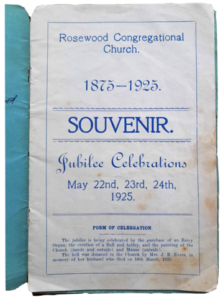 Pastoral Letter
Pastoral Letter
My Dear Friends,
The opening word of this letter must be one of sincere thanks. giving to our heavenly Father for all His unfailing mercy. This is the fiftieth anniversary of our Church and we are able to say, “Hitherto the Lord hath helped us.” By faith we can look out to the future in the assurance that God will be with us through all the days. At this jubilee let us resolve that we will strive to be more faithful to God by the grace of Christ and by the power of the Holy Spirit.
I commend this souvenir to your prayerful perusal. Remember that much has been done that cannot be recorded yet. Much seed has been sown-the fruitage will come in God’s own time.
I would tender my hearty thanks to you all for your kindness to me and for your devotion to the church. Let us still run with patience the race that is set before us. And now, brethren, I commend you to God and to the word of His grace, which is able to build you up and to give you the inheritance among all them that are sanctified.
Yours for Christ,
N. HOWARD FINCH.
Foreword
WE, the undersigned, having been appointed by the the Church to compile this Souvenir of the Jubilee, feel our responsibility most keenly. We have experienced great difficulty in procuring data for same, owing to the fact that no official records of the Church’s history have been kept. Consequently we recognise that so far as the ” History” is concerned, it is somewhat vague and incomplete. However, we trust that our effort will meet with general approval, as we present this little booklet, not for its historical value, hut as a memento of this memorable occasion.
Yours faithfully,
N. H. FINCH. C. WILLIAMS. H. CAPERN. May, 1925.
SUNDAY SCHOOL WORK
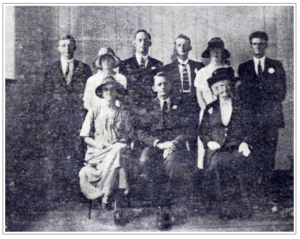 About the same time that services were commenced in Mr. Waight’s house, a Sunday school was started at the residence of the late Mr. J. W. Vance by Miss Vance (later Mrs. Mary Evans) with Mr Hannant acting as Superintendent. The school was continued there until the erection of the church in 1875. Mr. Hannant carried on the work for eleven months, after which Mr. S. Waight was appointed to the position of Superintendent by the church, a position he held for many years. Mr. W. Yarrow, Senr., was next appointed as Superintendent followed by Mr. T. H. Howell. After Mr. Howell’s resignation, Mrs. C. A. Capern was Superintendent for about twelve months, when Mr. Howell again took up the work for two years, being eventually followed by the present Superintendent, Mr. John W. Evans.
About the same time that services were commenced in Mr. Waight’s house, a Sunday school was started at the residence of the late Mr. J. W. Vance by Miss Vance (later Mrs. Mary Evans) with Mr Hannant acting as Superintendent. The school was continued there until the erection of the church in 1875. Mr. Hannant carried on the work for eleven months, after which Mr. S. Waight was appointed to the position of Superintendent by the church, a position he held for many years. Mr. W. Yarrow, Senr., was next appointed as Superintendent followed by Mr. T. H. Howell. After Mr. Howell’s resignation, Mrs. C. A. Capern was Superintendent for about twelve months, when Mr. Howell again took up the work for two years, being eventually followed by the present Superintendent, Mr. John W. Evans.
SUNDAY SCHOOL STAFF (Photo)
Back: Mr, C. Harding, Miss D. Williams (Organist), Mr. W. Snow, Mr. S. Harding (Sec.), Miss Vera Smith, Mr. E. J. Connolly
Sitting: Mrs. Finch (Treasurer), Mr. J. W. Evans (Superintendent), Miss McLaughlin.
OFFICERS IN 1925
Superintendent: Mr. J. W. EVANS; Secretary: Mr. S. R. HARDING; Treasurer: Mrs. N. H. FINCH; Assistant Secretary: Mr. C. RICHARDSON; Organist: Miss DOREEN WILLIAMS.
LIST OF MEMBERS 1925
Mrs. Barbara Elder; S. Waight (Foundation Member); W. Yarrow; J. H. Jacobs; Mrs. Jacobs; Miss Howell; T. H. Howell; H. M. Stevens; C. Williams; Mrs C. Williams; Miss D. Williams; F. A. Perrin; Mrs. Mary Evans; J. W. Evans; Mrs. J. W. Evans; W. Mason; J. Mason; Mrs. Mason; Mrs. H. Capern; H. S. Capern; P. N. Capern; Mrs. P. Capern; A. Capern; A. H. Krause; Mrs. A. H. Krause; T. Krause; V. Krause; Mrs. Edith Dutney; C. Dutney; E. T. Harding; Tom Harding; Mrs. T. Harding; G. Harding; J. Harding; S. Harding; Mrs. S. Harding; Miss Mabel Rea; Mrs. J. Downing; Mrs. A. Rea; J. Bowles; Mrs. Bowles; Mrs W. K Johnston; Mrs. Kapernick; Mrs. A. J. Loveday; Mrs. Koch; W. Koch; Mrs. W. Krause; W Krause; Mrs C. Allen; Mrs. Imrie; Miss C. Brown; Miss A. Brown; Miss M. Brown; Miss K. Marshall; Mrs. Smith; Mrs. H. Rice; Miss E. Rice; Mrs. W. Wyatte; Mr. V. Wyatte; Mrs. Finch; Rev. N. H. Finch; Mrs. J. Rea; Jack Rea; Mr. Alec Rea; Glen Rea; Mrs. Johns; Miss Johns; Miss V. Grant; L. C. M. Rea; Mrs. E. Hughes; Miss G. Grimsey; Miss S. Wyatte; Mrs. W. Baills; Miss H. Hawkins; Miss M. Paroz; Mrs. D. Elder; Mr. W. Snow; Mr. W. Wyatte; Miss A. Allen; Mrs H. Bassett; H. Bassett; Miss H. Downing; Mr. E. Connolly; Mrs. Jackwitz; C. Wass; Mrs. Wass; H. Wendt; Mrs. Wendt; Miss V. Smith; A. Chalk; Mrs. Chalk; Mrs. Snow; Miss R. Cover.
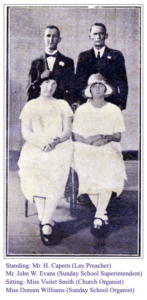 CHURCHES IN THE DISTRICT
CHURCHES IN THE DISTRICT
ROSEWOOD (Secretary, Mr C.Williams)
HAIGSLEA (Secretary, Mr J. Koch)
WALLOON (Secretary, Mr H. Harris)
MT. WALKER (Secretary, Mr W. H. Stokes)
TENNIS CLUB (Formed in 1903)
President: Rev. N. H. FINCH.
Vice-Presidents: Messrs. A. J. LOVEDAY, C. WILLIAMS, J. M. BRUCE, H. DUTNEY.
Secretary: Miss D. ALLEN.
Captain: Mr. A. B. CLARK.
Vice-Captain: Mr. A. CAPERN. (The late Mr. J. E. EVERS was Patron up to the time of his death.)
WOMENS’GUILD
The Women’s Guild was formed in 1916, with Mrs. C. A Capern as President, Mrs. G. Brown (now of Ipswich) as Vice-president and Mrs. T. Harding as Secretary and Treasurer (still held this position in 1925). They rendered yeoman service to the church, assisting both socially and financially. On two occasions they catered at the Rosewood Show. A special effort in their “Sale of Work” was held each year with good results. The Guild also took in hand the arrangements for the Anniversary Tea Meeting each year. The officers in 1925 were: President: Mrs. FINCH, Secretary and Treasurer: Mrs. T. HARDING. Members: Twenty.
BALANCE SHEET OF CHURCH, Year ending 31st December 1924

Audited by C. WILLIAMS & H. CAPERN and found correct.
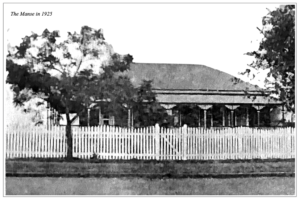
This photograph was originally lent by Mrs. Mary Evans, of Rosewood in 1935.
GREETINGS FROM FORMER MINISTERS
REV. A. CASTLEMAN, M.A.
With great pleasure do I send greetings to the members of the Congregational Church, meeting in Rosewood, on this jubilee occasion. I look back on the time that I spent with them as pastor as among the most fruitful years of my life: though the endeavor to maintain efficiently the work of the Pastorate, and at the same time to assist in moulding our future ministry through our  Theological College in Brisbane, at length brought about the breakdown in health which compelled my retirement.
Theological College in Brisbane, at length brought about the breakdown in health which compelled my retirement.
The ideal of the Christian ministry with which I entered on my work-the determination, with Paul, not to know anything among you save Jesus Christ and Him Crucified-was confirmed by the response, on many occasions, to the call to service and sacrifice, not only in connection with the immediate activities of the Church Fellowship, but also for the moral and spiritual uplift of the people of the town and district, in whose interests we were laboring for Christ’s sake.
I pray that God’s richest blessing may accompany these celebrations, and that the years to come may be yet richer and mere fruitful in Service. Love and Sacrifice to the Glory of His Holy Name.
A BRIEF MESSAGE FROM THE REV. A. E. WEST, NOW OF LONGUEVILLE, SYDNEY.
It is high honor indeed for a church to have the privilege of witnessing for Christ in a community for half a century. The things for which Christ and the Church stand are the things which matter most in our personal and national life-love, truth, justice, Christian charity, the redemption and betterment of mankind. Such as these sweeten, strengthen, and preserve the race, I pray that the Church, in whose ministry I spent five and a half busy, happy years, may still lift up an ensign for the people” and many continue to give of her best with a passion that nought shall slacken and with a faith that nought can dim. A. E. WEST
MESSAGE FROM REV. C. A. CAPERN
My Dear Friends,
I sincerely congratulate you on the occasion of the completion of 50 years work in connection with the Church, in which it was my privilege to spend seven very happy years. May the Great Head of the Church be pleased to grant that you may become increasingly useful as the days go by, and enable you to fully appreciate the powerful influence that the Church exerts in any community, because she stands for the things Essential. Love is her Watchword. May you not only learn to hate the things that are evil, but Love the things which are noble and good and true and right. Keep on keeping on, and may you grow in grace and in the knowledge of our Lord and Savior Jesus Christ.
C. A. CAPERN, Toowoomba.
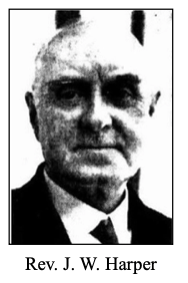 In July 1925 Rev. Nelson Howard Finch and his wife left with their three sons for Port Chalmers, New Zealand. Rev. Joseph William Harper arrived to fill the vacancy temporarily, and officially began a lay pastorate two years later.
In July 1925 Rev. Nelson Howard Finch and his wife left with their three sons for Port Chalmers, New Zealand. Rev. Joseph William Harper arrived to fill the vacancy temporarily, and officially began a lay pastorate two years later.
- Rev. Harper purchased his own car. The accounts changed from horse feed to petrol charges.
- Youth work was strengthened by the introduction of the Junior Christian Endeavour Movement.
- Much experience was gained in witnessing and work for the Master, not only in the Church, but in the community as well.
- Mrs. Harper was the leader in women’s work and Sunday School. A personal letter was sent to all young people inviting them to a meeting to form a Young People’s Club.
- A building fund for a new church opened with a deposit of £49.
Continued in part two..
© Jane Schy, 2024
Published 25/10/24
